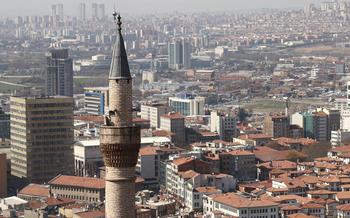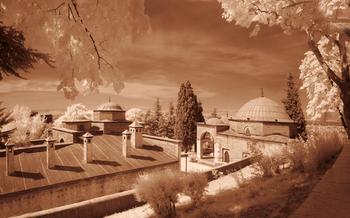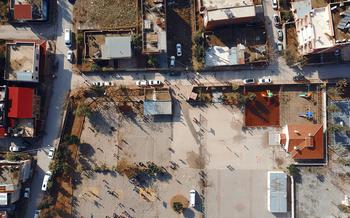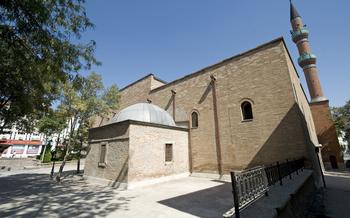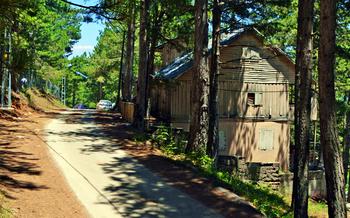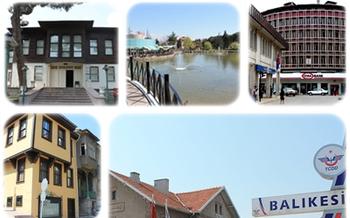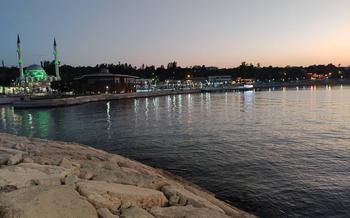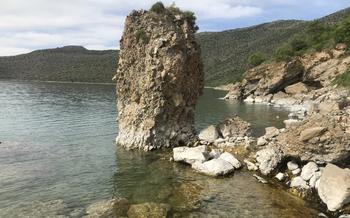
Halilur Rahman Mosque
- Historical Significance
- Location
- Architecture
- Interior Design
- Prayer Halls
- Courtyards: Tranquil Spaces for Contemplation and Community
- Minaret
- Dome
- Prayer Times
- Visitor Etiquette
- Pilgrimage and Festivals
- Local Cuisine
- Nearby Attractions
- Local Handicrafts: Treasures to Take Home
- Insider Tip: Embracing the Spiritual Atmosphere
Historical Significance
The Halilur Rahman Mosque, a beacon of Islamic faith and heritage, stands as a testament to the rich history and cultural significance of Van. Built in the 16th century, the mosque has served as a place of worship and pilgrimage for generations of Muslims. Its architectural features and design elements reflect the essence of Islamic traditions, blending harmoniously with the surrounding cityscape. The mosque's intricate tilework, calligraphy, and soaring minarets showcase the artistry and craftsmanship of its builders, creating a sacred space that inspires awe and devotion.
Location
The Halilur Rahman Mosque is majestically situated in the heart of Van, Turkey, a city renowned for its rich cultural heritage and breathtaking natural beauty. It stands as a beacon of faith and spirituality, inviting pilgrims and visitors alike to immerse themselves in its sacred ambiance. The mosque's prime location, within easy reach of other prominent landmarks, makes it an ideal starting point for exploring the city's diverse attractions. Whether arriving by car, public transportation, or on foot, visitors will find the mosque conveniently accessible, ready to unveil its architectural wonders and spiritual essence.
Architecture
The Halilur Rahman Mosque showcases a distinctive architectural style that blends traditional Islamic elements with regional influences. Constructed using locally sourced stone, brick, and tile, the mosque features a harmonious combination of geometric patterns, intricate carvings, and elegant calligraphy. The central dome, adorned with turquoise tiles, dominates the skyline and serves as a symbol of divine presence. The tall and slender minaret, with its intricate balconies and ornamentation, stands as a testament to the skill and artistry of the mosque's builders. The use of arches, vaults, and domes creates a sense of spaciousness and grandeur, while the intricate tilework and calligraphy add a touch of sophistication and elegance to the overall design.
Interior Design
The interior of the Halilur Rahman Mosque is a testament to the exquisite craftsmanship and devotion of its builders. As you step inside, your eyes are immediately drawn to the intricate tilework that adorns the walls and ceilings. Verses from the Quran, rendered in elegant calligraphy, weave their way through elaborate patterns, creating a mesmerizing tapestry of faith.
The mosque's prayer halls are vast and airy, with soaring columns supporting a series of domes that seem to float effortlessly overhead. The mihrab, the niche indicating the direction of Mecca, is a masterpiece of artistry, featuring intricate carvings and colorful mosaics that draw the eye towards the heart of the mosque.
Stained-glass windows, casting multicolored hues across the interior, bathe the space in a soft, ethereal glow. Each window tells a story, depicting scenes from Islamic history and tradition, adding to the mosque's rich narrative.
The ablution fountains, where worshippers perform ritual cleansing before prayers, are adorned with intricate carvings and tilework, transforming a practical necessity into an aesthetic marvel. The arrangement of prayer halls, courtyards, and other functional areas within the mosque is both practical and harmonious, allowing for seamless movement and congregation.
Prayer Halls
The prayer halls within the Halilur Rahman Mosque are designed to accommodate large congregations of worshippers and facilitate their prayer rituals. The main prayer hall is a vast and awe-inspiring space, capable of accommodating thousands of worshippers at a time. It is characterized by its elegant arched ceiling, intricate tilework, and serene atmosphere. The floor of the prayer hall is covered with soft carpets, providing a comfortable space for worshippers to perform their prayers.
-
Mihrabs: The qibla wall of the prayer hall features a beautiful and ornate mihrab, a niche that indicates the direction of Mecca. The mihrab is adorned with intricate carvings, calligraphy, and tilework, symbolizing the importance of this sacred space.
-
Minbars: The prayer hall also features a minbar, a raised platform from which the imam delivers sermons and leads the prayers. The minbar is intricately carved and decorated, reflecting the craftsmanship and artistry of the mosque's builders.
-
Qibla Walls: The qibla walls of the prayer halls are adorned with intricate tilework and calligraphy, emphasizing the importance of facing Mecca during prayer. The qibla walls serve as a visual reminder of the unity and direction of the Muslim community.
-
Prayer Areas: The prayer halls are divided into separate sections for men and women, ensuring privacy and modesty during prayers. Special arrangements, such as designated areas or prayer rooms, are often made for women and disabled visitors, ensuring their comfort and ease of worship.
Courtyards: Tranquil Spaces for Contemplation and Community
The Halilur Rahman Mosque boasts serene and tranquil courtyards that offer a sanctuary for relaxation and contemplation. These open spaces, often surrounded by lush gardens and water features, provide a welcome respite from the hustle and bustle of city life. Visitors can stroll through the shaded areas, immersing themselves in the tranquility of the surroundings. The courtyards serve as gathering spaces for community events and social interactions, fostering a sense of togetherness and belonging among the faithful. Whether seeking a moment of solitude or engaging in communal activities, the courtyards of the Halilur Rahman Mosque offer a unique and enriching experience for all visitors.
Minaret
The minaret of the Halilur Rahman Mosque stands tall and slender, piercing the skyline of Van. As one of the most prominent features of the mosque, the minaret serves a vital role in Islamic architecture, calling the faithful to prayer with its melodious adhan. The tall, cylindrical structure is adorned with intricate carvings and decorative elements, reflecting the rich artistry of Islamic craftsmanship.
The minaret's design is not merely functional but also symbolic, representing the connection between heaven and earth. Its height and visibility symbolize the ascension of prayers towards the heavens, while its graceful form evokes a sense of spirituality and devotion. The minaret's strategic placement ensures that the call to prayer can be heard from afar, inviting the community to unite in worship and devotion.
The minaret of the Halilur Rahman Mosque is not just a structural element but a symbol of faith and a reminder of the importance of prayer in Islamic tradition. Its presence adds a distinct charm to the cityscape of Van, making it an iconic landmark that draws the attention of both locals and visitors alike.
Dome
The Halilur Rahman Mosque boasts a magnificent dome, a defining feature of Islamic architecture. Constructed using intricate techniques and materials, the dome rises elegantly above the mosque, symbolizing the heavens and divine protection. Its exterior is adorned with intricate tile work or lead, reflecting the region's rich craftsmanship. The interior of the dome is often decorated with celestial motifs, creating a sense of awe and spirituality. The dome's design and construction showcase the mosque's architectural prowess and its significance as a place of worship and pilgrimage.
Prayer Times
The Halilur Rahman Mosque, like all other mosques around the world, observes specific prayer times throughout the day. These prayer times are determined by the position of the sun and are essential in Islamic tradition for Muslims to fulfill their religious obligations.
The five daily prayers observed at the mosque are Fajr (dawn), Dhuhr (noon), Asr (afternoon), Maghrib (sunset), and Isha (night). Each prayer has a specific time window during which it should be performed, and the exact timings may vary slightly depending on the season and location.
Attending congregational prayers at the mosque is considered a highly meritorious act in Islam. It fosters a sense of community and unity among the believers, as they come together to worship and seek divine guidance. The mosque provides a serene and conducive environment for Muslims to offer their prayers and connect with their faith.
For non-Muslim visitors who wish to experience the spiritual atmosphere of the mosque, it is important to be respectful of the religious practices and customs. Visitors are welcome to observe the prayers from a designated area without disturbing the worshippers.
It is advisable for visitors to check the local prayer times before planning their visit to the mosque to ensure they can participate in the prayers if they wish. The mosque's administration or local Muslim community can provide guidance on the specific prayer timings for each day.
Visitor Etiquette
When visiting the Halilur Rahman Mosque, it is essential to be mindful of appropriate attire and behavior to show respect for religious customs and traditions. Dress modestly, avoiding revealing or tight-fitting clothing, and remember to remove your shoes before entering the mosque. Maintain a respectful silence within the prayer halls and courtyards, and avoid engaging in loud conversations or disruptive activities. Photography is generally permitted, but it is advisable to ask for permission before taking pictures of people or sensitive areas. Non-Muslim visitors are welcome but should be respectful of the religious practices and rituals taking place within the mosque. By following these simple guidelines, visitors can contribute to a harmonious and peaceful atmosphere for all.
Pilgrimage and Festivals
The Halilur Rahman Mosque holds a significant place as a pilgrimage site for Muslims, particularly during religious festivals. The annual Hajj pilgrimage to Mecca is a particularly important time for the mosque, as many pilgrims stop here to pay their respects and seek blessings before continuing their journey.
During the holy month of Ramadan, the mosque comes alive with special events, prayers, and celebrations. The mosque's courtyards and prayer halls are filled with devout worshippers, who gather for Taraweeh prayers, Quran recitals, and Iftar meals. The atmosphere during Ramadan is particularly spiritual and uplifting, as the community comes together to celebrate and reflect on their faith.
Other important festivals observed at the mosque include Eid al-Fitr and Eid al-Adha. These festivals mark the end of Ramadan and the completion of the Hajj pilgrimage, respectively. During these times, the mosque is decorated with colorful lights and banners, and special prayers and ceremonies are held to commemorate the occasion.
Attending religious festivals at the Halilur Rahman Mosque is a unique and rewarding experience. It offers visitors a glimpse into the rich spiritual traditions of Islam and the deep sense of community that exists among the faithful.
Local Cuisine
Indulge in the culinary delights of Van when visiting the Halilur Rahman Mosque. The city offers a diverse range of local dishes and delicacies that are sure to tantalize your taste buds. Savor the flavors of Van's traditional breakfast, known as Van Kahvaltısı, which includes a variety of cheeses, honey, clotted cream, and freshly baked bread. Don't miss the opportunity to try Murtuğa, a unique dish made from wheat flour, meat, and vegetables, or Ayran Aşı, a refreshing yogurt soup. For a sweet treat, indulge in Van Dondurması, a local ice cream famous for its unique texture and rich flavor. Head to Kazancılar Çarşısı, the city's vibrant market, to sample these delicacies and find authentic local products to take home as souvenirs.
Nearby Attractions
Beyond the Halilur Rahman Mosque, Van offers a wealth of historical, cultural, and natural attractions that visitors can explore. The Van Castle, perched atop a hill overlooking the city, is a must-see for its stunning views and well-preserved architecture. The Van Museum houses a rich collection of artifacts and exhibits that showcase the region's rich history and cultural heritage.
For nature enthusiasts, Lake Van, the largest soda lake in the world, is a natural wonder not to be missed. Visitors can embark on boat tours to explore the lake's unique ecosystem and admire the stunning landscapes that surround it. The Akdamar Island, located in the middle of the lake, is home to the beautiful Armenian Church of the Holy Cross, a testament to the region's diverse cultural heritage.
To delve deeper into Van's past, visitors can explore the ancient ruins of the Urartu Kingdom, including the impressive Van Fortress and the Toprakkale archaeological site. These remnants of a once-powerful civilization offer a glimpse into the region's rich history.
For those seeking a unique cultural experience, the Van Cat House is a must-visit. Home to the famous Van cats with their distinctive white fur and piercing blue eyes, this attraction provides visitors with an opportunity to learn about and interact with these beloved felines.
Local Handicrafts: Treasures to Take Home
Van is renowned for its vibrant tradition of local handicrafts, offering visitors an opportunity to take home unique souvenirs that reflect the region's rich cultural heritage. One of the most iconic items is the Van carpet, famous for its intricate designs, vibrant colors, and exceptional craftsmanship. These carpets are meticulously hand-knotted by skilled artisans using traditional techniques passed down through generations.
In addition to carpets, Van is also known for its exquisite pottery. Local artisans create a variety of ceramic pieces, including decorative plates, vases, and bowls, each adorned with unique patterns and motifs inspired by the region's history and traditions. Visitors can find a wide selection of pottery at local markets or specialty shops.
For those seeking something more personal, jewelry is a popular choice. Van's jewelers craft beautiful pieces using a variety of materials, including gold, silver, and semi-precious stones. Intricate designs and delicate filigree work characterize these ornaments, making them treasured keepsakes.
To find the best selection of local handicrafts, visitors should explore the Van Bazaar, a bustling marketplace where vendors display their wares. Here, shoppers can bargain for unique items and experience the vibrant atmosphere of a traditional Turkish bazaar.
Whether it's a hand-knotted carpet, a piece of intricately designed pottery, or a delicate piece of jewelry, a local handicraft from Van is a tangible reminder of the region's rich cultural heritage and a cherished souvenir for visitors to take home.
Insider Tip: Embracing the Spiritual Atmosphere
As you step into the hallowed halls of the Halilur Rahman Mosque, let the serene and spiritual atmosphere envelop you. Embrace the opportunity to connect with the local community by joining the congregational prayers. This is a profound experience that allows you to immerse yourself in the traditions and rituals of Islam. Remember to dress modestly and respectfully, and be mindful of local customs and etiquette during your visit. The mosque's tranquil courtyards offer a perfect sanctuary for quiet reflection and contemplation. Take a moment to pause, find a peaceful corner, and let the tranquility of the surroundings wash away the stresses of daily life. The Halilur Rahman Mosque is a place of profound spiritual significance, and embracing its sacred essence will undoubtedly enrich your visit.
